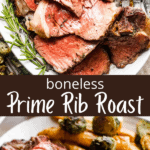This post may contain affiliate links. Please read our disclosure policy.
Perfectly tender, perfectly juicy, and deliciously seasoned, this show-stopping Boneless Prime Rib Roast is a bold and beautiful Holiday dinner recipe packed with flavor.
Don’t forget to grab a side of jus from my roasted prime rib au jus to go with your boneless prime rib roast. And if you’re looking for more cozy roast recipes, try my pork roast and this hands-free slow cooker coq au vin.

Easy Boneless Prime Rib Roast Recipe
Sometimes, cooking involves teasing the best flavor and texture from challenging ingredients. But, other times, it’s about letting your already amazing ingredients shine! That’s how I feel about prime rib roast. These roasts are top-of-the-line in terms of quality, flavor, and tenderness, so I like to use a very simple set of seasonings and techniques, allowing the prime rib to be the star that it is!
This roast is a showstopper, perfect for special occasions like Christmas dinner, on par with a succulent roast turkey and gravy. Everyone needs a reliable Prime Rib Roast recipe, and this one is a winner, sure to impress every time.
What Is Prime Rib?
At the grocery store, you’ll typically find two grades of prime rib meat: USDA prime grade and USDA choice grade. Prime grade boasts more fat and marbling, making it a delicious, juicy cut, but that’s the more expensive option. If in doubt, consult your butcher to clarify whether you’re getting a prime or choice cut, as the packaging might not always indicate this. More often than not, the cuts available are of the “choice” grade.
When shopping for a boneless prime rib, you might encounter various labels for this cut of meat. It can also be referred to as a “standing rib roast,” “beef rib roast,” “boneless ribeye roast,” or “boneless rib roast.” This can be a bit confusing, so if you’re uncertain, don’t hesitate to ask the butcher for assistance so that you will purchase the correct cut and avoid any mix-ups.

Ingredients For Prime Rib
This recipe is for a 3 to 4-pound boneless roast. I like to use boneless prime rib roasts because they are easy to carve and also because it’s easier to calculate how much roast you have and need. A good estimate is ½-pound per person so a 3-pound roast will feed six people. However, if sticking to the recommended weight of a single serving size, a 3-pound roast can feed 8 and up to 10 people.
- One Prime Rib Roast: I recommend buying a boneless roast between 3 and 4 pounds.
- Salt and Pepper: You’ll need a generous amount to season a roast this size! I use two teaspoons of kosher salt and one of ground pepper.
- Butter: Soften the butter before using.
- Thyme and Rosemary: I use dried herbs in this recipe, one teaspoon of dried thyme and half a teaspoon of rosemary.
- Garlic Powder: This gives a wonderful, savory flavor to the meat.
- Bay Leaf: A whole bay leaf is essential for that classic roast-beef aroma and taste.


How To Cook A Boneless Prime Rib Roast
You’ll need a few special items to make this roast the best it can be. Kitchen twine is one of those items. Is it possible to make the toast without tying it up? Definitely! But tying it will result in the most even cooking and juicy roasting, so I really do recommend it. It’s also A MUST to have an instant-read meat thermometer and a good roasting pan. I use a big cast iron skillet.
- Bring the Roast to Room Temperature (Roughly). Take the beef out of the fridge one hour before you’re ready to cook it. Let stand at room temperature.
- Preheat the Oven and Dress the Roast. Preheat your oven to 450˚F. Sprinkle salt and pepper all over the beef. In a small bowl, combine the softened butter, thyme, garlic powder, rosemary, and crushed bay leaf; mash with a fork until combined and rub this mixture all over the roast. Finally, tie kitchen twine around the roast at 2-inch intervals, to create a tidy bundle.
- Pre-Roast at High Heat. Place the seasoned and tied beef in a large cast iron skillet. Roast in the preheated oven for 15 minutes, to seal in the juices.
- Continue Roasting at a Lower Heat. Turn down the oven temperature to 325˚F and continue to roast until the internal temperature of the beef reaches 120˚F. Make sure to start checking for doneness around the 35-minute mark, so you have an idea as to how much longer you need to cook it. It’s very important to use an instant-read thermometer to check the meat, because it is fast and accurate and won’t interrupt the cooking process needlessly.
- Cool and Slice the Roast. When the roast is done to your liking, remove it from the oven and transfer the beef to a cutting board. Cover it with foil and let it stand for 20 minutes before slicing. When ready, slice the roast as thinly as you prefer and serve immediately.

Recipe Tips
- Take Time into Account. It’s very important to allow enough time for this recipe! You need a whole hour before cooking to let it come to room temperature, plus half an hour afterward to let it stand before carving.
- Don’t Cover While Cooking. It’s common to tightly cover certain types of meat, to give it the most tenderness, but prime rib does better uncovered. The high temperature at the beginning of the roasting sears the meat, sealing in juices; that’s all you need! No covering required.
- Test the Temperature Early. As the roast gets closer to being done, the internal temperature goes up faster and faster. So check it a little early, and continue to check fairly frequently until it hits your target temperature. And, remember, it will continue to cook after you take it out of the oven.
What Goes With Prime Rib?
- Bread: Perfect for sopping up leftover juices, serve this prime rib with a side of homemade dinner rolls or butter swim biscuits.
- Potatoes: I love pretty much any potato dish, and so does this roast! From braised potatoes to loaded potatoes au gratin, to garlic Parmesan roasted potatoes and hassleback potatoes, it’s all amazing!
- Cauliflower: Potatoes not your thing? Try my creamy mashed cauliflower for a perfect low-carb side!
- More Veggies: My easy oven roasted asparagus with Hollandaise sauce is a perfect complement to a hearty boneless prime rib roast, as are these creamy green beans with mushrooms and air fryer Brussel sprouts.
- Salad: Pair this roast with a side salad, like this Brussels sprouts salad or cranberry chicken salad.

Storing and Reheating Leftovers
- To refrigerate, put in airtight containers or wrap leftovers tightly and seal in food storage bags. Leftovers will keep for up to 5 days in the refrigerator.
- To reheat, place prime rib in a baking dish. Add a splash of beef broth (or leftover gravy, au jus, etc), and cover tightly with foil. Bake at 300˚F until heated through. The amount of time will vary depending on how large and thick the piece(s) of roast are.
- To freeze, wrap leftovers tightly in two layers of plastic wrap, and then seal into freezer bags, pressing out as much air as possible. Leftovers will keep for 4 to 6 months. Thaw in the refrigerator for 24 hours before reheating.
Pin this now to find it later
Pin It
Boneless Prime Rib Roast
Ingredients
- 3 to 4 pound boneless prime rib roast
- 2 teaspoons kosher salt,, or to taste
- 1 teaspoon freshly ground black pepper,, or to taste
- 4 tablespoons unsalted butter,, softened
- 1 teaspoon dried thyme
- 1 teaspoon garlic powder
- ½ teaspoon dried rosemary
- 1 dry bay leaf,, crushed
Instructions
- Take the beef out of the fridge one hour before you’re ready to cook it, and let it stand on the counter at room temperature.
- Preheat oven to 450˚F.
- Season the beef all around with salt and pepper.
- In a small mixing bowl, combine softened butter, thyme, garlic powder, rosemary, and crushed bay leaf. Mash with the back of a fork until completely combined. Rub the butter mixture all over the beef.
- Using kitchen twine, tie the roast at 2-inch intervals. Tying the roast is not a must, but in doing so, your roast will cook more evenly, and it will retain its shape.
- Place the roast in a large cast iron skillet and pop it in the preheated oven for 15 minutes.
- Turn down the oven temperature to 325˚F and continue to roast until the internal temperature of the beef reaches 120˚F. Start checking for doneness around the 35-minute mark, so you have an idea as to how much longer you need to cook it. Most importantly, use an instant read thermometer to check for doneness. There’s no other way to tell if the meat is done to your likeness.
- When done, remove the prime rib from the oven and transfer it to a cutting board. Cover it with foil and let stand for 20 minutes before slicing.
- Slice and serve.
Notes
- Preheat the Oven: Ensure the oven is preheated to the correct temperature before placing the roast inside.
- Use a Meat Thermometer: Monitor the internal temperature to avoid overcooking. Aim for 120°F for rare, 130°F for medium rare, or 135°F for medium.
- Season Generously: Apply a liberal amount of seasoning to penetrate the thick cut of meat, enhancing its flavor.
- Rest Before Cooking: Allow the seasoned roast to sit at room temperature for about an hour to let the flavors meld.
- Rest After Cooking: Let the roast rest after cooking. This allows the juices to redistribute, ensuring a moist and flavorful roast.
- Sharp Knife: Use a sharp knife for clean cuts to maintain the juiciness and presentation of the meat, and cut the meat against the grain for tender slices.
Nutrition
Nutritional info is an estimate and provided as courtesy. Values may vary according to the ingredients and tools used. Please use your preferred nutritional calculator for more detailed info.









Roast turned out perfect, major hit! Only regret is that I didn’t get a larger roast! Seasoning was perfect , and the family loved it!
That’s great! I am very glad you enjoyed it! Thank YOU! :0
Yum! This looks so delicious and full of flavor! I can’t wait to give this recipe a try! So excited!
What a perfect Christmas dinner this must make! I’m so excited to try it out.
Thank YOU! I hope you enjoy it! 🙂
This is so good and delish!! Such a great addition to our holiday menu!
I hope you and your family enjoy it! Thank YOU! 🙂
This Boneless Prime Rib Roast is seriously making me hungry!
I hope you enjoy it! Thank YOU! 🙂
Lovely! An ideal dish for the holidays or any special occasion. Great step-by-step instructions!
Thank you so much! I hope you enjoy it! 🙂
I’m all about easier to carve so I’ll take boneless, too! This looks so delicious and flavorful. And cooked to perfection!
Thank YOU! I hope you enjoy it! 🙂
Ok, I’m drooling!! This is so juicy, tender, & delicious! This makes the perfect holiday meal!
I hope you enjoy it! Thank YOU! 🙂
Everyone at my house loved this!! A huge hit at my house!
I am very glad you enjoyed it! Thank YOU! 🙂
Should the cast iron skillet be placed in the oven while it’s preheating? So that the roast will be on a hot skillet.
Hi!
It’s not necessary, but you can definitely do that if you like. The initial high heat of 15 minutes at 450˚F will help with browning the meat and locking in those juices.
Wow! This turned out so fantastic! What a crowd pleaser!!! Small crowd this year (4) but still! 🙂
That’s great! I am very glad you enjoyed it! Thank YOU! 🙂
I must’ve made hundreds of these back when I was in the restaurant industry. But the primals we get always have a GIANT fat cap on them.
Well I got one from work this year with no fat cap and wasn’t sure how “civilians” cook theirs without all that fancy industrial equipment.
Thanks for the tips! I’m sure this will turn out great even without a team of prep cooks next to me.
It’s in the oven now 😁
I know about those fat caps! 😄 Yes, the only “fanci-er” equipment you’ll need here is a food thermometer. 😊 I hope you’ll enjoy the roast! Have a very Merry Christmas and Happy Holidays!